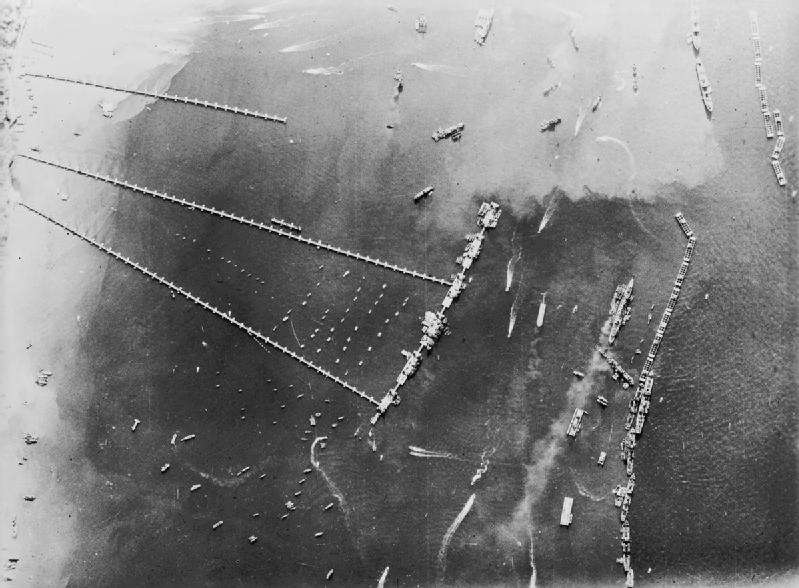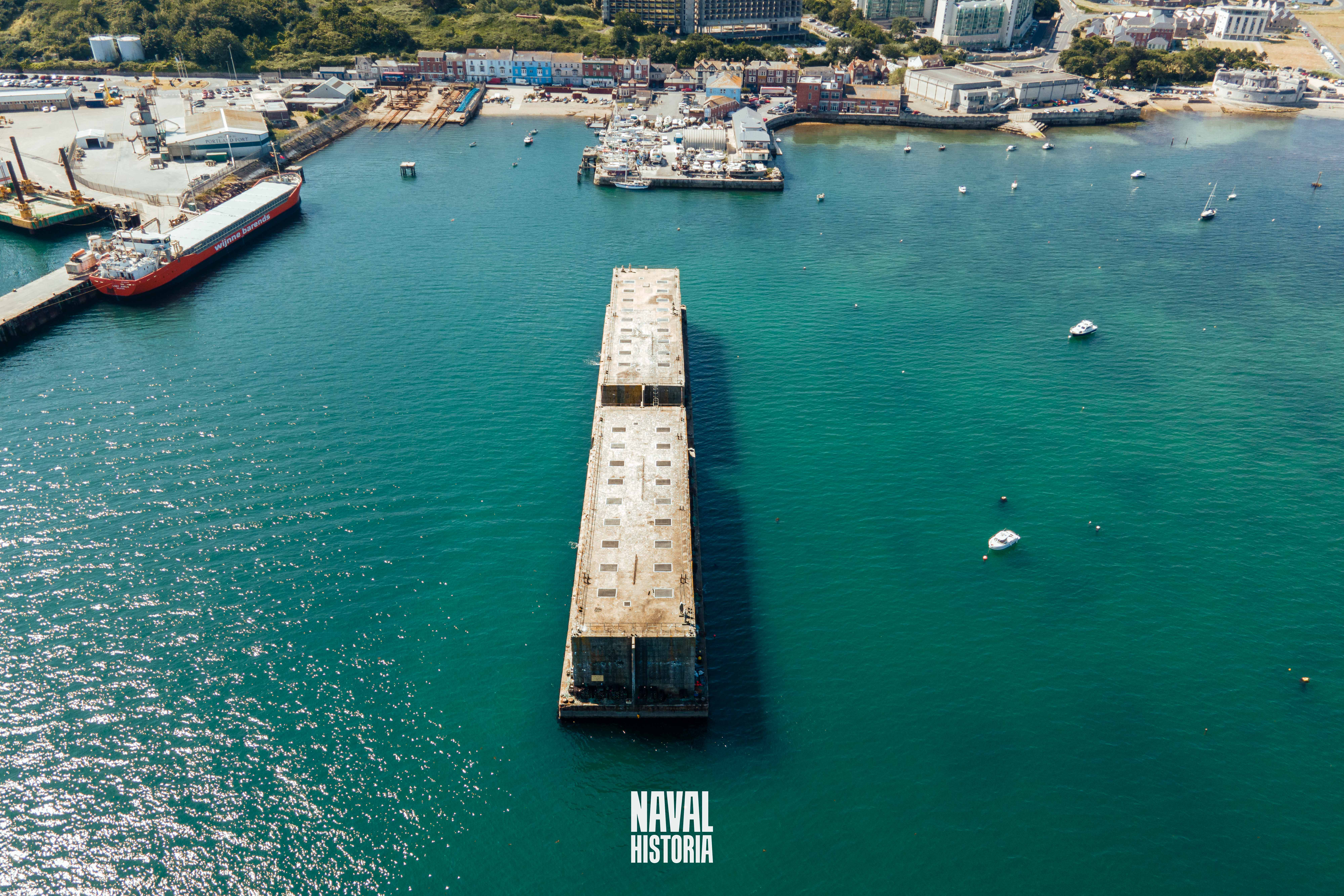Today we went to Portland Harbour on the south coast of England in the County of Dorset to see some amazingly well preserved examples of the Phoenix breakwater.
Phoenix breakwaters were an instrumental, yet often overlooked, part of the revolutionary and strategically crucial Mulberry harbours that played a pivotal role during the Second World War.
These mobile ports, designed to sustain the Allied invasion of Normandy, were engineered marvels, and the Phoenix breakwaters were an integral component of their structure.
Origins Of The Phoenix Breakwater
The concept of the Mulberry harbour emerged from the need for a rapid and reliable supply chain to support the D-Day invasion.
An ingenious plan was developed by the Allied forces to build two artificial harbours — Mulberry ‘A’ at Omaha Beach for the Americans, and Mulberry ‘B’ at Gold Beach for the British.
 Mulberry B, 27 October, 1944.
Mulberry B, 27 October, 1944.
These harbours, designed to be transportable, were intended to support the massive influx of troops, vehicles, and supplies needed to fortify the invasion.
Design
The Phoenix breakwaters were large concrete caissons designed to provide a buffer against the potentially tumultuous sea conditions of the English Channel.
Named ‘Phoenix’ due to the code name of the project, these concrete structures varied in size from the small ‘A1’, up to the ‘C1’ type at 6000 tons – the type that can be seen in Portland harbour today.
 A Phoenix caisson under construction in Southampton, April 1944.
A Phoenix caisson under construction in Southampton, April 1944.
The concept was relatively simple: the Phoenixes would be constructed in Britain, then floated across the English Channel, and sunk in their respective positions to form protective barriers around the harbours.
These barriers were designed to withstand both weather and wave actions, creating a calmer and safer environment for the landing of supplies and troops.
The construction and installation of the Phoenix breakwaters were feats of civil engineering.
Their design accounted for many factors, such as the weight and volume of concrete needed to withstand the wave action, the location where they would be sunk, and the need for them to be easily manoeuvrable across the Channel.
The caissons had to be initially buoyant for transportation, then quickly sinkable upon reaching their destination, a balance that required meticulous planning and execution.
More than 200 Phoenixes were constructed, with some still visible today, a testament to their design and durability. These structures are not just remnants of war but markers of human ingenuity under duress.
 We got the drone up to take a closer look.
We got the drone up to take a closer look.
How Big Are the Phoenix Caissons?
These large concrete buffers were made to be 60 ft tall, 204 ft long, and 62ft deep. Each of these Phoenix caissons were made to be sunk to break waves.
It is estimated that to make these caissons, over 300,000 cubic yards of concrete as well as 30,000 tons of steel were used.
Impact on the D-Day Invasion
While Mulberry “B” at Gold Beach (used by the British and Canadians) survived and was used for a significant amount of time, Mulberry “A”, situated at Omaha Beach and intended for use by the American forces, was not so fortunate.
A severe storm struck the Normandy coast on June 19, just a couple of weeks after the initial landings, and it lasted for three days. Unfortunately, this storm caused catastrophic damage to Mulberry “A”.
The harbour’s design was supposed to withstand rough seas, but the intensity of this particular storm, rated as a one-in-forty-year event, was too much for it.
The floating roadways got detached, breakwaters were overwhelmed by the waves, and many of the ‘beetles’ (floating pontoons that supported the pier roadway) sank.
Ultimately, the damage was so severe that it was considered beyond repair.
 Statues have recently been erected on top of the breakwaters, in memory of lost servicemen.
Statues have recently been erected on top of the breakwaters, in memory of lost servicemen.
This situation forced the Americans to rely heavily on the still-intact Mulberry “B” and on improvising additional logistics solutions, such as repairing captured German ports and increasing over-the-beach supply operations.
Despite the loss of Mulberry “A”, the Allies managed to maintain their supply lines, a testament to the robustness of their overall logistic operation.
The Phoenix Breakwaters At Portland Harbour
Some of the Phoenixes never made the journey across the Channel.
There are various reasons for this, including operational issues, damage during construction or movement, or simply because they were surplus to requirements.
Today, two of these remaining Phoenixes can be seen in Portland Harbour, where they serve as a poignant reminder of the significant wartime efforts.
 The establishment of the Mulberry harbours enabled the Allies to postpone the invasion of a major port until a firm base had already been secured.
The establishment of the Mulberry harbours enabled the Allies to postpone the invasion of a major port until a firm base had already been secured.
These structures have become iconic landmarks in their own right. Over the years, they’ve drawn attention from historians, engineers, and tourists alike, interested in their history and the ingenious engineering behind them.
Today, they also serve as a habitat for local marine life, highlighting how remnants of war can be reclaimed by nature.
Conclusion
The successful deployment of the Phoenix breakwaters and the creation of the Mulberry harbours had a profound impact on the outcome of the D-Day invasion.
The Mulberry harbours were instrumental in landing over 2.5 million men, 500,000 vehicles, and 4 million tons of supplies onto the shores of Normandy, effectively turning the tide of the war in favour of the Allies.
The protection afforded by the Phoenix breakwaters was vital in this endeavour, demonstrating the strategic value of these innovative structures.
 A line of Phoenix caissons with anti-aircraft guns fitted, 12 June, 1944.
A line of Phoenix caissons with anti-aircraft guns fitted, 12 June, 1944.
The Phoenix breakwaters of Portland Harbour stand as a silent tribute to the extraordinary wartime efforts and the groundbreaking engineering feat that played a pivotal role in the success of D-Day.
They are enduring symbols of the challenges faced and overcome by the Allies in World War II. Their history is a testament to human innovation, courage, and the relentless pursuit of freedom.